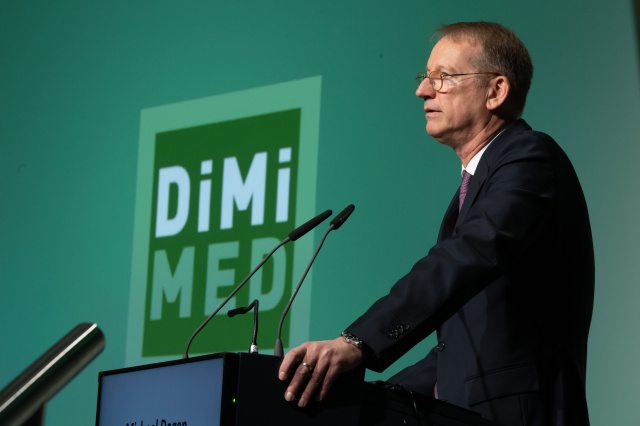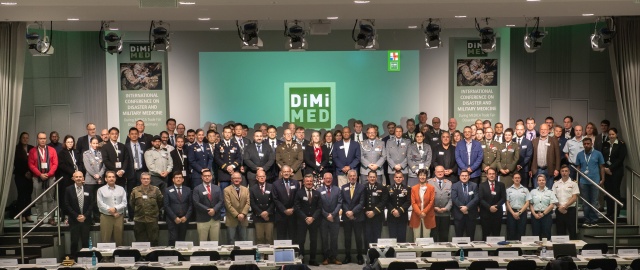
Report: Author: Brigadier General (ret.) Erwin Dhondt, MD, MSc, MHA, SFS (Former Director general Health & Well-being of the Belgian Defense Co-chairman DiMiMed)
Report of the 10th DiMiMED 2022
The 10th anniversary DiMiMed International Conference took place on the 14th and 15th November 2022 in Düsseldorf, Germany. This International Conference on Disaster and Military Medicine has, since its inauguration, developed into a renowned and unique component of MEDICA, the world’s largest medical trade exhibition. The scientific meeting brought together 185 participants from 31 different countries worldwide and was also attended by 20 partners and sponsors from the medical industry, under the expert sponsorship of the professional congress organizer ‘BETA Publishing and Marketing Company’.
The Welcome Address on behalf of the Messe Düsseldorf GmbH was given by Executive Director Michael Degen. He expressed the hope that the attendees would experience two exciting conference days with plenty of informative new insights and stimulating discussions, and expressed his gratitude to the disaster medicine and defense health community for its dedication and commitment when managing even the most serious crises, i.e., ‘if the worst comes to worst’.

In their joint Scientific Preview and Welcome Speech, the three co-chairs – Brigadier general (ret.) Rob van der Meer (NLD), Colonel (ret.) Gerald Kerr (IRL) and Brigadier general (ret.) Erwin Dhondt (BEL), joining the team from this year – took a short look back at the past decade of DiMiMed happenings and subsequently outlined this year’s conference program and main theme: “Health Service Delivery and Support for the Catastrophes and Complex Emergencies in the next Decade”.
For the purpose of setting the scene, Brigadier general dr. Bernd Mattiesen (DEU) from the Bundeswehr Medical Academy in Munich delivered the Official Opening Speech, followed by an inspiring Keynote by US Army Colonel (ret.) dr. Terry M. Rauch (USA), the Acting Deputy Assistant Secretary of Defense for Health Readiness Policy & Oversight (Health Affairs). He explained how military medicine will make a difference in tackling the future challenges of crises and complex emergencies.
Each of the two conference days started with general insights into evolving Disaster and Military Medicine brought together every morning in an exciting session on ‘Moving Points’.
A unique experience occurred with the opportunity to listen to a couple of VTC-reports directly from the war zone in UKR on the management of the injured with combat abdominal trauma. The Surgeon general of the Ukrainian Armed Forces explained his field experience with endovideosurgical intervention and another presentation involved an improved emergency ultrasound FAST-protocol, extended with colon and retroperitoneal assessments. Other topics in these generic sessions were: the added value of unmanned aircraft systems in support of tomorrow’s battlefield medical care (CZE); research, development and quality control challenges of novel autoinjectors (naloxone; TXA) as a more widespread future medical delivery form (ISR); the transformation of the Indonesian Health system towards increased readiness for the next crises.
Additional industrial presentations discussed computational modeling for a better control of oxygen delivery during mechanical ventilation in prolonged field care based on a patient’s pulse oximeter signal and the development of an antidote against ricin poisoning.

The ‘CBRN Medical Management’ session on Day 1 was compiled and led by US Army Lieutenant colonel Tommy Rezentes (USA), also chair of the NATO COMEDS CBRN Medical Training Panel, and had presenters from Belgium, Canada, Germany, and the United States. They told us about the use of computer modeling and simulation to test plans and develop policy, of technology use supporting telemedicine and data transmission, and also the use of medium and high-fidelity mannequins to make CBRN mass casualty training very realistic. Other presentations outlined the importance of innovative chemical exposure diagnostics and related treatment options for nerve agents and opioids, as well as of phage therapy as a possible new approach to support bio casualty management, given the potential for bio attacks that may include antibiotic resistant pathogens. Finally, we were invited to review years of CBRN medical research that may provide many answers to how we can optimize CBRN medical modernization.
The late-afternoon module of the 1st conference day was on ‘Infectious Diseases’, moderated, for several years now, by dr. Benjamin Queyriaux. Presentations focused on portable laboratory diagnostics for operationally important tropical and infectious diseases based on smartphone technology (MLT); on the contribution of operational epidemiology to the overall response to biological events (FRA); and on the impact of changing vector borne diseases epidemiology as a consequence of climate change and global warming, on medical support planning (PRT). A representative of the COSEMIL-research group on sexually transmitted infections (STI) in the French Armed Forces discussed future changes in prevention and management strategies following new findings on the role of women in STI transmission.
From the industry perspective, we got updates on both a live-attenuated Chikungunya vaccine candidate and a tetravalent Dengue vaccine candidate.
A discussion on the health security threat posed by modern mis- and disinformation concluded a first intense day of scientific satisfaction.
The module entitled ‘Disaster Medicine and the Humanitarian Perspective’ on Day 2, designed and chaired by dr. John Quinn from the Prague Center for Global Health at Charles University (CZE), consisted of presentations on: prehospital lessons learned from the war in UKR – to share and certainly not to be lost – with the eternal goal in mind to continuously support the reduction of preventable morbidity and mortality; Global Health Engagement (GHE) from the perspective of the USA European Command, focusing on NATO interoperability but also, and in particular, rehabilitation based GHE (USA); military healthcare ethics, applied to different situations (e.g. treatment of prisoners of war, medical research) and the use of scenario-based education with regard to that.
Between presentations, the audience was sustained by two vivid pitches from the industry: a masterclass on the use of chitosan-based hemostatics for (traumatic) bleeding control and a demonstration of a reliable surgical lighting system providing light for very demanding situations (e.g. battlefield). A reflection on behalf of the European Society for Emergency Medicine ‘Disaster Medicine’ section, on the interaction and coordination among civil healthcare systems, humanitarian responders and the military in supporting humanitarian assistance and disaster relief, closed this track.
The 2nd Day’s program concluded with the ‘Mental Health’ session. Moderator and another staunch ally of DiMiMed, Dutch Army Colonel (ret.) professor dr. Eric Vermetten had organized a remarkable line-up of speakers from Canada, The Netherlands and Ukraine (via VTC). Various presentations were delivered on the (re-)construction of a mental health care and rehabilitation system in the Ukrainian Armed Forces with the focus on the primary care level; including the importance of the detection ‘alexithymia’ and the management of ‘adjustment disorder’ following acute concussion. The use of a digital psychological first aid ‘self-help chatbot’ has been illustrated, providing recommendations adjusted for the ongoing stress of the war, as well as other technology-enabled solutions for addressing, for example, post-traumatic stress injury.
These presentations were again interspersed by another two industrial contributions: one on antidotal therapy with oximes in case of organophosphate poisoning and hydroxocobalamin for cyanide poisoning; and a second on the application of a computer simulator mapping how potential smallpox outbreaks might occur throughout the world.
During the final lecture, the entire audience was exposed to a captivating contemplation revealing that mounting exposure to traumatic and morally injurious experiences around the globe force us morally to embrace humanity: ‘interventional attunement’, empowering those victims and appealing to their strengths and hope, resilience and adaptability prior to, during and following these experiences are vital and strengthen them.
Before formally closing the 10th DiMiMED International Conference, outgoing DiMiMed Brigadier general (ret.) Rob van der Meer, on behalf of the scientific committee, awarded the Poster Prize worth 1000 euros to a Taiwanese research group studying the beneficial effects of hyperbaric oxygen therapy on the symptomatology and quality of life of patients suffering from Long COVID.
In conclusion, Rob van der Meer thanked for the very last time as Senior chairman, all involved, especially the audience, the presenters and moderators, the support staff from Messe Düsseldorf and BETA Publishing and Marketing Company and invited all attendees to visit the MEDICA Trade Fair.
Join us next year and save the dates of the 11th DiMiMed International Conference at the Trade Fair ‘Messe’ Düsseldorf: November 2023.

Date: 05/25/2023











